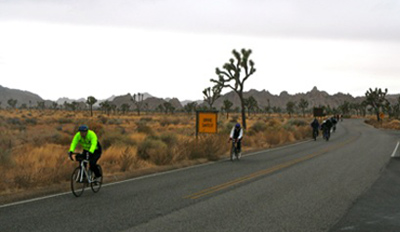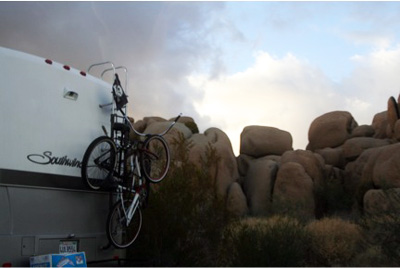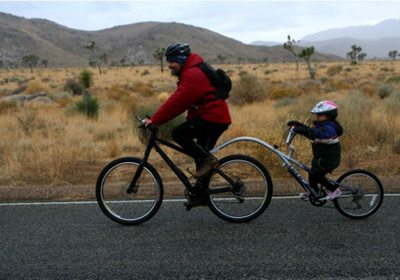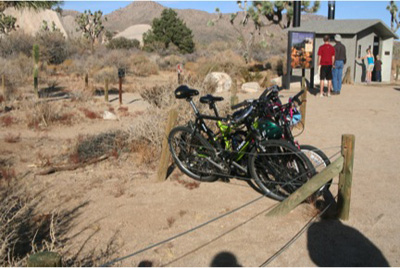
Park’s trails appeal to all kinds of bicyclists
TWENTYNINE PALMS, Calif. — Pumping the pedals up and down hills of rock-covered mountains while admiring the breath-taking high-desert landscape of Joshua Tree National Park is an invigorating way to exercise.
Joshua Tree offers bike riders miles of manageable bike trails full of views of the unique flora and fauna found in the park. The bike trails are perfect for bike riders who wish to train for races or who just want to relax. However, the trails are not meant for thrill seekers since biking is only allowed on paved or fire roads.
“Bikes are only permitted in roads that are open to vehicles. It is a service issue. They are still trying to work out some sort of service-wide policy across of the national parks about bikes. Until the policy is finalized, we cannot invest money to improve bike usage,” said Joseph Zarki, Joshua Tree’s chief of Interpretation.
| Joshua Tree National Park has various trails for people to enjoy. Large groups are able to bike but they have to get a permit from the park (Photos by Rosa Orihuela). |  |
The roads are not very wide and the older roads do not have wide shoulders, so it is not a good experience for a bike rider. If we add bike lanes on the road, the road gets a lot bigger and it impacts the environment. It is a trade-off. If we had wide roads, the turtles trying to cross will find it more dangerous,” he added.
Joshua Tree bike trails may not get the adrenaline pumping for some bike riders, but they do offer a pleasant biking experience. Bikers can explore desert plants and animals up-close in an environment that is out of this world. It is an unforgettable biking experience unlike any other.
“I ride through the bike lane to Cottonwood and I never had an issue. No requirements of skill, just wear a helmet. I like going downhill and uphill in Cottonwood. It is a nice ride,” said Pam Tripp, lead ranger for Cottonwood and Night Sky Program ranger.
Bike riders need to stay on established roads to protect the park’s natural features.
 |
Bike riding is a family activity that everybody can do in Joshua Tree. Most bike roads are easy to moderate so everyone can enjoy a ride through the park. |
Bicycle tire tracks on the open desert can last for years and can seriously spoil the landscape. Southern California has many places that offer legal single tracks, but Joshua Tree is not one of them. Bike riders who venture on backcountry trails will do a considerable damage to the environment.
Roads that are open for bike riders are narrow with soft shoulders. It is important to pay close attention when rounding corners since curves, boulder piles and Joshua trees restrict the vision of the road.
Since bike riding is heavily restricted, it is not as popular as other activities but it stills draws large crowds.
“We do not discourage bike riding; numerous groups of bike riders come during the year. We ask them to get a permit from the park because they are going to be impacting traffic flow. We do that so we can give them support but individual bike riders do not need that,” said Zarki.
Mountain biking in the desert can be a strenuous activity, so bike rides must carry plenty of water to stay hydrated and safe. It is recommended to bring one gallon per person and two gallons for long or uphill trails.
Wearing a helmet is always necessary when riding a bike, but even more so in the desert. Falling in any of the tracks can cause a serious injury due to Joshua Tree’s rocky landscape. It is vital to take the proper precautions because open bike roads are very narrow with sandy shoulders, bumps and potholes.
“I tried to bike near the mountain, but the soil is like sand and it did not work. I did not bike much, but I enjoyed it,” said Jeff Mehert, a first-time park visitor from Wisconsin.
| Most people bike to get around the park and as a way to exercise. It is not a rare sight to see RV’s with bikes in the back since people try to use their cars the least possible. |  |
Due to the lack of visibility and the constant flow of RVs and trucks, bikes should have an extended side-view mirror. Joshua Tree gets very dark at night, so riders should wear reflective clothing as well.
Visitors can bring their own bikes or rent bikes from the nearby bike rentals in Palm Springs and Yucca Valley. The sport has higher demand during the winter season because the temperatures are comfortable compare to Europe.
“Our peak demand months are between October and April when the weather is pleasant here and crummy in most other places in North America and Europe,” said Evan Trubee, a United States Cycling Federation racer and founder of Big Wheel Tours in nearby Palm Desert.
Even though, Joshua Tree is known for is hiking trails as the sport of mountain biking gains popularity more and more visitors are choosing to bike through the park.
“We have seen more people interested in mountain biking and biking in general since we started in 1996,” said Trubee.
Joshua Tree offers several bike trails that range from easy to strenuous. For example, Old Lost Horse Road Trail is a manageable 4.5-mile round trip trail. It begins at Ryan Campground and travels through Lost Horse Valley to the Quail Springs Historic Trail. It offers scenic views and bike riders can see the different landscapes the park has to offer.
It was previously open to cars only, but a new re-vegetation plan has stopped the access of cars and allows bike riders to enjoy the trail.
A more strenuous trail is the 10-mile Thermal Canyon Bike Trail. This is the only trail in Joshua Tree that is open to bike riders and not horses. The trail takes the bike rider through the peculiar rock formations of the Cottonwood Mountains. The trail is very long, so riders who do not finish the trail on the first day can camp overnight as long as they are register at the Pleasant Valley Backcountry Board.
 |
Most people who camp in Joshua Tree use bikes to get around and enjoy the different hiking and rock climbing trails. Helmets are not mandatory, but they are highly encourage. |
Joshua Tree has many more bike trails to explore, but if visitors do not like long bike rides, bikes are usually use to get around the camp site as well.
“People come from all around to hike the trails. I mostly bike to get around, but it is a good exercise. Riding is awesome and invigorating,” said Mike Edwards, a California native who often visits the park.
Joshua Tree’s bike trails may not be the place for riders seeking off-road rough terrain trails. However, the trails are a perfect place for those riders who want to train for a race and get adjusted to the changes in altitude or for recreational bike riders seeking a relaxing ride.
The beauty and uniqueness of this Southern California desert will make any bike riding experience unforgettable.
If You Go
- Hours of Operation: Open 365 days a year but there are some areas with restricted access at night.
- Cost: There is a national park entry, fee but there are exceptions during the annual National Parks Week, held in April entry fees are waived in more than 100 parks nationwide.
- Location: The park is located in Twentynine Palms, Calif. Joshua Tree is north of I-10 near Palm Springs. It is 150 miles east of Los Angeles, 175 miles northeast of San Diego and 215 miles southwest of Las Vegas.
- How Long: Visits require a minimum of a few hours up to several days for camping
- Best Time to Visit: Spring and fall have the best weather.
Bike Trails (Joshua Tree Traveler):
- The main road through the park is a terrific road bike ride. It can be accessed through both the west and eastern park entrances. (Moderate)
- California Riding and Hiking Trail — seven miles one way (Moderate)
- Old Lost Horse Road Trail — five miles one way (Easy)
- Old Queen Valley Historic Road Trail — 4.8 miles one way (Easy)
- Thermal Canyon Bike Trail — 10 miles one way (Strenuous)
- Old Dale Road, a 23-mile 37.3-kilometer road. The first 11 miles cross the Pinto Basin, a flat sandy dry lakebed. Then a steep climb crosses the park boundary. A number of side roads go off to old mines and residences. The main road leads to State Highway 62 in 29 Palms. This bike trail requires camping. (Strenuous)
- Geology Tour Road. An 18-mile road that can be sandy.
- Black Eagle Mine Road.

Comments are Closed